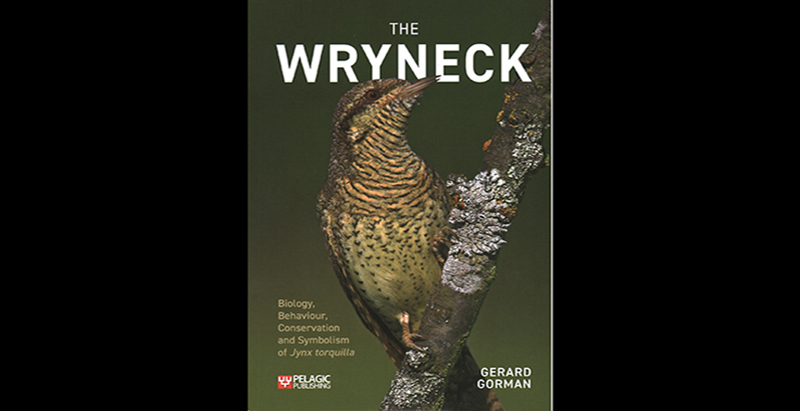
The Eurasian Wryneck is the woodpecker that doesn’t look like a woodpecker, the bird with the portmanteau name that is also a medical condition (and which may remind some people of a Nora Ephron essay). It’s a unique bird, even its scientific name is wonderful, so it’s not surprising that Gerard Gorman, Woodpecker Expert Supreme, has written a book all about the species. The Wryneck: Biology, Behaviour, Conservation and Symbolism of Jynx torquilla covers every aspect of the anatomy, evolutionary history, life cycle, behavior, and cultural significance of Jynx torquilla. It is written in the scholarly literature framework of the monograph, “a learned treatise on a small area of learning,”* but in a nontechnical style and language accessible to any interested naturalist, a point he makes passionately in his Preface.
From the Preface, Kindle edition; copyright © 2022 Gerard Gorman
Wrynecks are fascinating because they are woodpeckers, taxonomically and evolutionarily, yet they do not share many behaviors and anatomical features of most members of the Picidae family. They are beautiful, but in a different way. Instead of bold swatches of red, white, and black, or repetitive designs of black-and-white stripes, checks, and dots, or elegant bodies of olive-green, Wryneck plumage is a subtle, intricate patterning of brown, gray, buff, and black with elements of buff-yellow streaking, much closer to a nightjar than a typical woodpecker. They are slim and small-headed birds and their bills are fine, not strong and dynamic. They forage on the ground (well, we know other woodpeckers who do that), and tend to spread out on a branch of a tree rather than perch upright or use their tails for support. They tap rather than drum, and don’t use the sounds to announce themselves or mark territory. They are also one of the few woodpecker species that don’t drill their own cavities for nesting, using natural holes or re-using old holes of other woodpecker species.
But they are woodpeckers: the genus Jynx of the subfamily Jynginae of the Picidae family. I was surprised to learn that there are two Wryneck species in the Jynx genus: Eurasian Wryneck, Jynx torquilla, and Red-throated Wryneck, Jynx ruficollis. The latter is a nonmigratory, African endemic with a scattered, limited distribution. Most of this book is about Eurasian Wryneck, as the subtitle indicates, though Red-throated Wryneck is referred to throughout and there is a chapter focused on the species.
Gorman explores the evolutionary history of the Wryneck and its taxonomy in the first chapter, in a way establishing the authenticity of its woodpecker status. He charmingly says that the Wryneck may be the most primitive woodpecker, lacking many evolutionary adaptations, or it may be the most advanced woodpecker, having gone from eating insects in trees to ants on the ground. It’s an open question. The book then goes on to explore all facets Wryneck, a total of 16 chapters, working its way from taxonomy to physical features (anatomy and morphology, description and identification, molt, aging and sexing); Red-throated Wryneck; communication; its relationship with the physical world (distribution and status, habitats, conservation); behavior (displays and mimicry, migration, breeding, nesting cavities and manmade nest boxes, foraging and food); relationships with other birds and animals; and finally what I thought was the most fascinating chapter, folklore, mythology, and symbolism. Here are just a few things that I learned: It is almost impossible to tell male and female Wrynecks apart, which means we still don’t know a lot about which sex does what when it comes to parenting or, indeed, any behavior. They are ant specialists. They may eat other insects if they have to, but all they really want are ants and Gorman lists 24 species of ant that are part of their diet in Europe, any life stage will do. They mimic snakes, a claim to fame that goes all the way back to Aristotle’s History of Animals. Their heads and necks writhe and twist and they make hissing noises when threatened, earning them the old English name “snakebird” (take that, Anhinga!) and the rural Austrian folk name natterzunge or ‘adder tongue.’
Gorman has read and distilled probably every research study ever written about Wrynecks or related to them; my quick count of the citations in the 16-page References section came to 295. Practically every sentence is documented with these studies. Yet, The Wryneck does not read like a literature review. Gorman’s personal field experience informs much of the text and his total grasp of the field means he relates one research finding to another with narrative ease. This is a very easy book to read. I do wish that Gorman included more of his personal experiences and stories in the natural history tradition of ornithologists like Alexander Skutch. Probably the most personal chapter is the one on cavities, which includes very specific instructions about how to build nest boxes for Wrynecks, a photo of Gorman setting up a box, and his personal observations of what works and what doesn’t work.
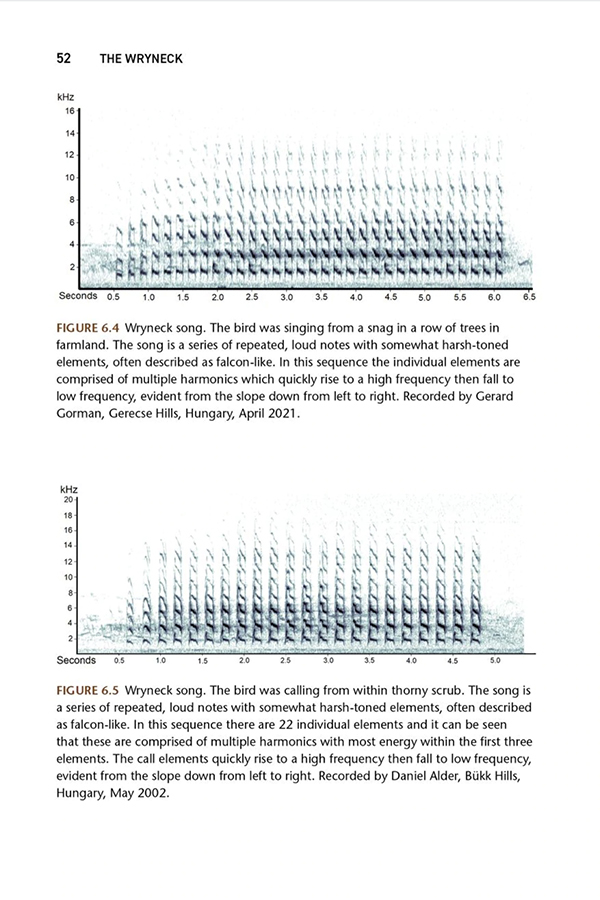 copyright © 2022 Gerard Gorman
copyright © 2022 Gerard Gorman
The Wryneck is full of stunning photos of Wrynecks–anting, flying, nesting, writhing, being ringed, their habitat areas, nests, eggs, and closeups of museum specimens. Illustrations also include distribution maps, spectogramsr illustrating vocalizations, and, in the last chapter, full-page artwork from 19th-century publications. The photographers are listed in the front, under Acknowledgements, and are a mix of colleagues, researchers, tour guides, professional photographers, and of course, Gorman himself. Many photographic images are full or half-page, allowing us to enjoy the elegance or weirdness of the image. But every photo is clearly here for a reason, whether to show juvenile plumage or large egg clutches or illegal trapping (many of the images in the Challenges and Conservation chapter are from CABS, the Committee Against Bird Slaughter). In addition to the illustrations, the book is well-designed with a very readable font, section headings in a brown font (sort of Wryneck plumage brown), and chapter names on the upper right-hand page. A 10-page Index is very helpful in locating topics, including country information.
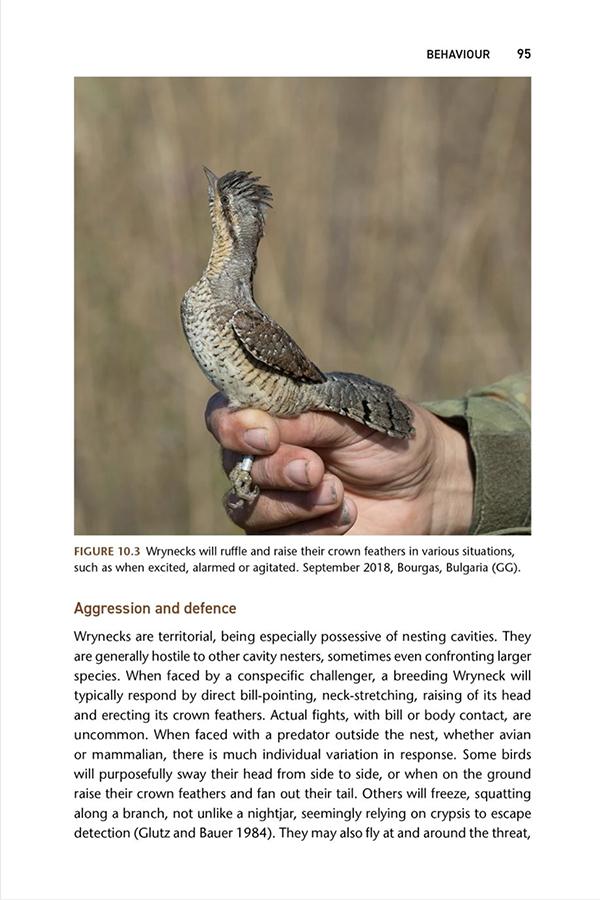 copyright © 2022 Gerard Gorman
copyright © 2022 Gerard Gorman
Gerard Gorman is a prolific writer on woodpeckers and related topics. This is his third woodpecker monograph; The Black Woodpecker: a monograph on Dryocopus martius, published by Lynx in 2011 and The Green Woodpecker: A monograph on Picus viridis was self-published in 2020 (and it looks like it will also be published in an updated version by Pelagic Publishing, according to Gerard’s Facebook page, in which he gives regular updates on all his writing projects). His titles also include RSPB Spotlight Woodpeckers (Bloomsbury, 2018), Woodpecker (Reaktion Bks, 2017), Woodpeckers of the World: A Photographic Guide (Firefly, 2014, published in Great Britain by Bloomsbury under the title Woodpeckers of the World: The Complete Guide), A Guide to Birdwatching in Hungary (Bloomsbury, 2014), Woodpeckers of Europe: a study of the European Picidae (Bruce Coleman, 2004), The Birds Of Hungary (Helm, 1996), and, interestingly, Pocket Guide to Tracks and Signs (Bloomsbury, 2014). Gorman also leads bird tours in central and Eastern Europe and posts photos and updates on his work on his own website and, as I said before, Facebook.
I’ve seen Eurasian Wrynecks two times, once in India, not a very good look, and once in northern Thailand, a memorable encounter involving a chance glance from my third-floor hotel window down to a neighboring field, an unusual movement and silhouette, and a grab for my bins and camera. I somehow knew right away that the bird I saw was a Wryneck. Gorman says that it’s sometimes mistaken for a songbird, but to me its sinuous silhouette could only belong to the Wryneck. And it turned out that I was the only person on our large tour that saw a Wryneck, it was my bird. So, I was curious to read more about Wrynecks, and now that I have I really want to see more of them in the field. And I hope that’s possible. Like many species, Wryneck numbers are on the decline. It is not considered endangered, indeed, the IUCN’s Red List rates it as a species of “Least Concern.” But Gorman points out that we really don’t know much about the species outside of Europe and that the usual explanations for population decline–loss of habitat, trapping, climate change–don’t explain startling changes predating these trends, such as their extirpation as breeding birds in Great Britain.
My Wryneck, Fang, Thailand, February 2019; copyright © Donna L. Schulman
The Wryneck: Biology, Behaviour, Conservation and Symbolism of Jynx torquilla by Gerard Gorman is a comprehensive monograph presenting current research about Eurasian Wryneck (and also much coverage of Red-throated Wryneck) in lively and very readable prose, well-illustrated by photos, scientific diagrams, and historic drawings. Written by a most prolific and enthusiastic writer and field observer of woodpeckers, probably THE most prolific and enthusiastic, it is a notable contribution to ornithological literature and one that I hope is selected for purchase by academic bibliographers and librarians. Birders, naturalists, and graduate students with a special interest in woodpeckers or Central European breeding birds might also want to consider it for purchase, though it is comparably expensive (it’s actually cheap for a scholarly book, those are increasingly being priced for institutional purchase). There is much more information here than you’ll find in the online Birds of the World or any collective natural history of woodpeckers, and you’ll be prepared for when you look out of your hotel window and see a weird, cryptic yet familiar shape.
*Merriam-Webster, https://www.merriam-webster.com/dictionary/monograph
The Wryneck: Biology, Behaviour, Conservation and Symbolism of Jynx torquilla
by Gerard Gorman
Pelagic Publishing, 2022, 202pp.
ISBN-10:1784272884; ISBN-13:978-1784272883
6.28 x 0.58 x 9.28 inches
$41.99; Kindle version available


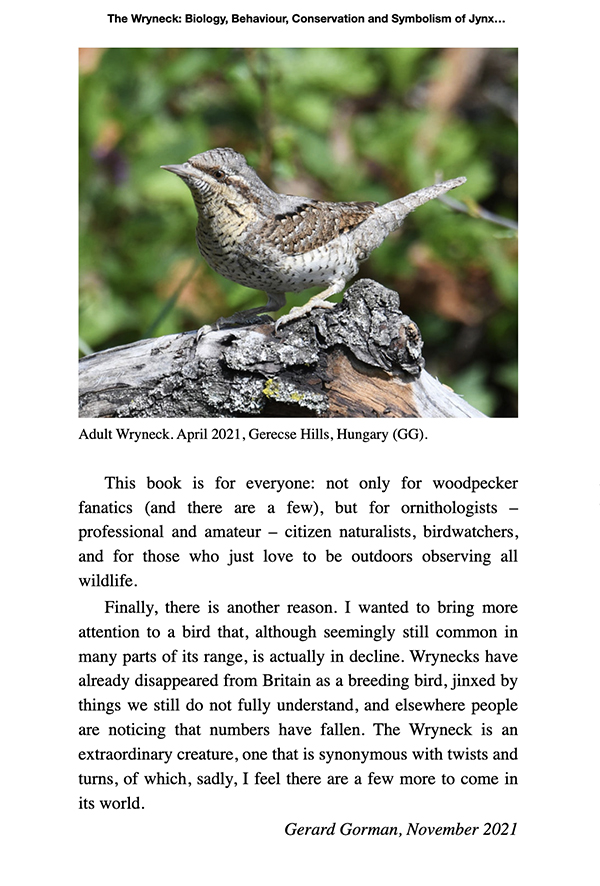
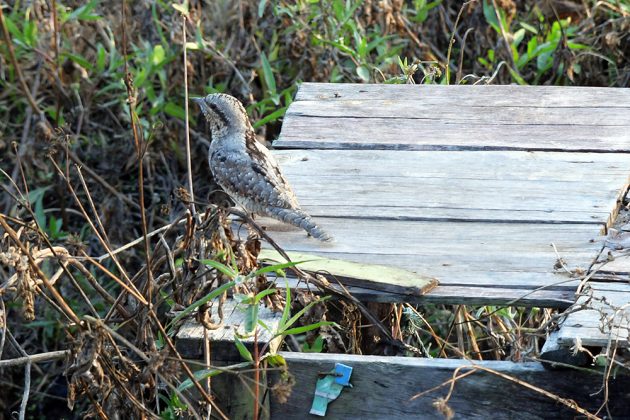











Dear Donna, Thank you so much for that very positive review. Gerard.